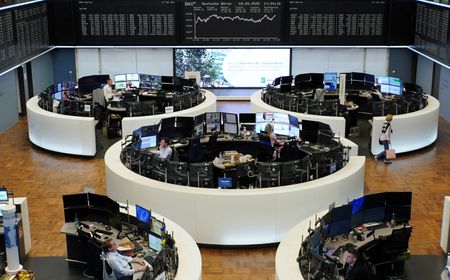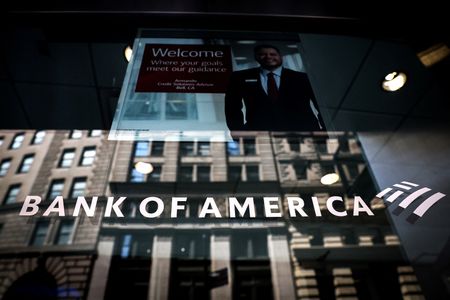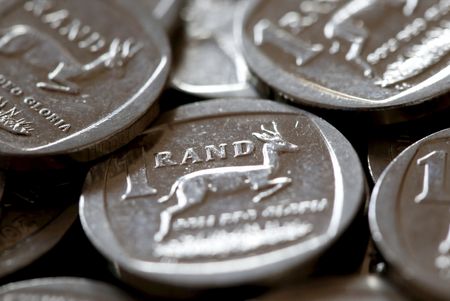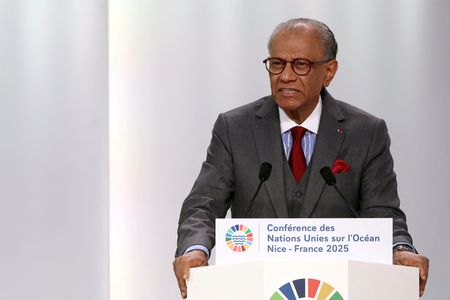By Sinéad Carew and Nell Mackenzie
NEW YORK/LONDON (Reuters) -MSCI’s global stock index rose to record levels on Monday for a third consecutive session with a few U.S. technology stocks leading on Wall Street while gold prices rallied to fresh records and the dollar pulled back.
Investors were digesting mixed messages about future interest rate cuts from Federal Reserve officials, as well as the latest U.S. immigration news after U.S. President Donald Trump said on Friday that U.S. companies would need to pay $100,000 for new H-1B worker visas, a potential blow to the U.S. tech sector.
Wall Street indexes built on last week’s string of records, marking their third record closing highs in a row. The bulk of the gains were from megacaps Nvidia and Apple Inc after Nvidia announced a $100 billion investment and analysts said demand for Apple’s latest iPhone appeared strong.
“Right now we’re depending on very narrow leadership. Also the market’s been going straight up all month, all quarter and since April started. You can have some consolidation and it’s perfectly appropriate,” said Michael O’Rourke, chief market strategist at JonesTrading in Stamford, Connecticut.
Fed Governor Stephen Miran said on Monday that the Fed is misreading how tight it has set monetary policy and will put the job market at risk without aggressive rate cuts, a view countered by three of his colleagues who said that the central bank needs to remain cautious about inflation.
St. Louis Fed President Alberto Musalem said that after last week’s rate cut there may be limited room for further reductions, given that inflation is still above the Fed’s 2% target. And Atlanta Fed President Raphael Bostic said he does not currently see the need for further interest rate cuts this year due to inflation concerns, according to an interview published by the Wall Street Journal on Monday.
Cleveland Fed President Beth Hammack said she felt policy at this point was not that restrictive and that the Fed needs to be careful about easing due to inflation.
“Most of the Fed speakers except for Miran are on the hawkish side, but the market is up so it’s not affecting the market,” O’Rourke said.
However, with more Fed officials including Chair Jerome Powell due to speak and key inflation data due out later in the week, Carol Schleif, chief market strategist at BMO Private Wealth Management, said that the trading week could be volatile.
On Wall Street all three major indexes had opened lower. But by the end of the session, the Dow Jones Industrial Average had risen 66.27 points, or 0.14%, to 46,381.54, while the S&P 500 closed up 29.39 points, or 0.44%, at 6,693.75. The technology-heavy Nasdaq Composite climbed 157.50 points, or 0.70%, to 22,788.98.
MSCI’s gauge of stocks across the globe rose 3.69 points, or 0.38%, to 985.44. Earlier, the pan-European STOXX 600 index closed down 0.13%.
Meanwhile, Argentine financial assets rallied on Monday, with stocks rising the most in six months and closing up 7.5%, according to provisional closing data. Its international dollar bonds rose more than 6 cents and the peso strengthened after Washington pledged full support for Argentina’s right-wing government ahead of key midterm elections next month.
India’s benchmark indexes lost ground after Trump’s H-1B announcements, as India’s $283 billion information technology sector, which gets more than half its revenue from the U.S., is expected to feel the pain in the near term. The move follows Trump’s doubling of tariffs on imports from India last month to as much as 50%, partly due to New Delhi’s purchases of Russian oil.
In currencies, the U.S. dollar was poised to snap a three-day winning streak against the euro and the Swiss franc as investors monitored the Fed comments.
The dollar index, which measures the greenback against a basket of currencies including the yen and the euro, fell 0.4% to 97.33. The euro was up 0.47% at $1.1799 while against the Swiss franc, the dollar weakened 0.4% to 0.792.
Against the Japanese yen, the dollar weakened 0.12% to 147.76.
In U.S. Treasuries, yields were little changed as the market appeared to have settled down following the Fed interest rate cut last week for the first time in 2025.
The yield on benchmark U.S. 10-year notes rose 1.3 basis points to 4.152%, from 4.139% late on Friday, while the 30-year bond yield rose 1.4 basis points to 4.7704%.
The 2-year note yield, which typically moves in step with interest rate expectations for the Federal Reserve, rose 2.5 basis points to 3.607%.
In energy markets, oil prices were close to flat as worries of oversupply were countered by geopolitical tensions in Russia and the Middle East.
U.S. crude settled down 0.06%, or 4 cents, at $62.64 a barrel and Brent ended the session at $66.57 per barrel, down 0.16% or 11 cents on the day.
In precious metals, gold prices hit fresh record highs, buoyed by investors’ heightened expectations of a dovish rate-cut path, ahead of remarks by Fed officials and key inflation data later in the week.
Spot gold rose 1.71% to $3,746.83 an ounce. U.S. gold futures rose 2.09% to $3,748.20 an ounce.
“There’s a continued flow of safe-haven demand amid geopolitical matters that are still kind of wobbly, including the Russia-Ukraine war. Last week’s Fed interest rate cut and probably more Fed rate cuts coming by the end of the year” are also supporting prices, said Jim Wyckoff, senior analyst at Kitco Metals.
In cryptocurrencies, bitcoin fell 2.77% to $112,229.90.
(Reporting by Sinéad Carew, Noel John, Nell Mackenzie and Ankur Banerjee; Editing by Shri Navaratnam, Jacqueline Wong, Bernadette Baum, Chizu Nomiyama, William Maclean and Edmund Klamann)









